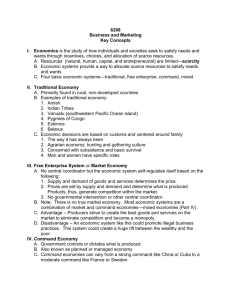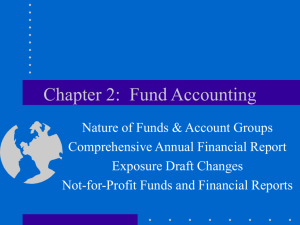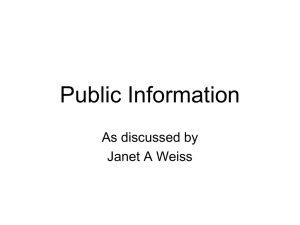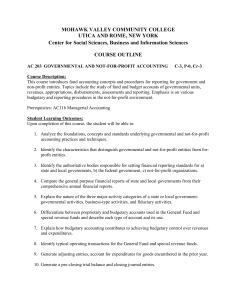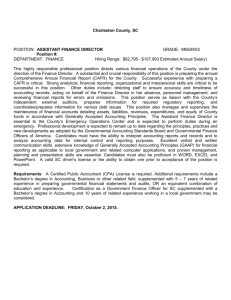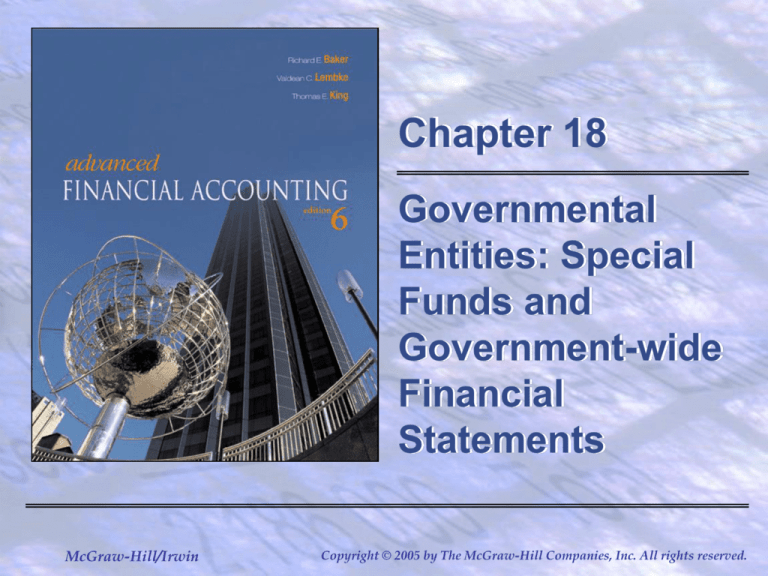
Chapter 18
Governmental
Entities: Special
Funds and
Government-wide
Financial
Statements
McGraw-Hill/Irwin
Copyright © 2005 by The McGraw-Hill Companies, Inc. All rights reserved.
Governmental Entities
• In addition to the general fund, discussed in
Chapter 17, governments have a number of
other funds.
• This chapter presents the accounting and
financial reporting requirements for:
• The four remaining governmental funds.
• The two proprietary funds.
• The fiduciary funds.
18-2
Governmental Entities
• A local governmental uses as many of these
funds as necessary for its operations or as
required by law.
• In practice, the funds and account groups
are often identified with the acronyms from
the first letters of their titles as found in the
next two slides.
18-3
Governmental Entities
• Governmental Funds
• GF
• SRF
• DSF
• CPF
• PF
General Funds
Special Revenue Funds
Debt Service Funds
Capital Projects Funds
Permanent Funds
18-4
Governmental Entities
• Proprietary Funds
• EF
• ISF
Enterprise Funds
Internal Service Funds
• Fiduciary Funds
• PTF
• ITF
• P-PTF
• AF
Pension Trust Funds
Investment Trust Funds
Private-Purpose Trust Funds
Agency Funds
18-5
Governmental Entities
• Governmental units should establish and
maintain those funds required by law and sound
financial administration.
• Only the minimum number of funds consistent
with legal and operating requirements should be
established, however, because unnecessary
funds result in inflexibility, undue complexity,
and inefficient financial administration.
18-6
Governmental Entities
• A general rule followed in many governmental
entities is that all activities should be accounted
for in the general fund unless specifically
required by law or the GAAP to be accounted
for in another fund.
• This rule does not prohibit the creation of
additional funds but places a reasonable
restraint on the proliferation of additional funds.
18-7
Governmental Entities
• One event may require entries in several funds.
For example, the construction of a new
municipal building through the issuance of
general obligation bonds may require entries in
both a capital project fund and a debt service
fund.
• In addition, interfund activities require entries in
two or more funds.
18-8
Special Revenue Funds
• Current governmental resources may be
restricted for specific purposes, such as
construction of the state highway system,
maintenance of public parks, or operation
of the public school system, city libraries,
and museums.
• The necessary revenue often comes from
special tax levies or federal or state
governmental grants.
18-9
Special Revenue Funds
• Some minor revenue may be earned through
user charges, but these charges are usually
not sufficient to fully fund the service.
• Special revenue funds are used to account
for such restricted resources.
• The governmental entity usually has a separate
special revenue fund for each different activity
of this type.
18-10
Special Revenue Funds
• Accounting for special revenue funds is the
same as for the general fund.
• The modified accrual basis of accounting is
used, no fixed assets or depreciation are
recorded in a special revenue fund, the
operating budget is typically recorded in the
accounts, and no long-term debt is recorded
in a special revenue fund.
18-11
Capital Projects Funds
• Capital projects funds account for the
acquisition or construction of major
capital facilities or improvements that
benefit the public.
• Examples are the construction of libraries,
civic centers, fire stations, courthouses,
bridges, major streets, and city municipal
buildings.
18-12
Capital Projects Funds
• A separate capital projects fund is created
at
the time the project is approved and ceases at
the completion of the project.
• Each project or group of related projects usually
is accounted for in a separate capital projects
fund.
18-13
Capital Projects Funds
• Accounting for capital projects funds is similar
to accounting for the general fund.
• The modified accrual basis of accounting is
used, no fixed assets or depreciation are
recorded in the capital projects funds, and no
long-term debt is recorded in these funds.
• Capital projects funds, however, typically do not
have annual operating budgets.
18-14
Debt Service Funds
• Debt service funds account for the accumulation and use of resources for the payment of
general long-term debt principal and interest. A
government may have several types of general
long-term debt obligations, as follows:
• Serial Bonds.
• Term Bonds.
• Special Assessment Bonds.
• Notes and Warrants.
• Capital Leases.
18-15
Serial Bonds
• Serial bonds
– The most common form of debt issued by
governments is in the form of serial bonds.
– The bonds are repaid in installments over
the life of the debt.
– A serial bond is called “regular” if the
installments are equal, “irregular” if they
are not equal.
18-16
Term Bonds
• Term bonds
– This form of debt is less frequent
now than in the past.
– The entire principal of the debt is
due at the maturity date.
18-17
Special Assessment Bonds
• Special assessment bonds are secured by
tax liens on the property located within the
special assessment tax district.
• The governmental unit may also become
obligated in some manner to assume the
payment of the debt in the event of default
by the property owners.
• Continued on next slide.
18-18
Special Assessment Bonds
• Special assessment bonds may be used to
finance capital projects, or to acquire other
assets, such as ambulances or fire engines,
necessary to operate the governmental unit.
• Special assessment bonds sold to acquire
enterprise fund assets, however, should be
accounted for within the enterprise fund.
• The special assessment feature simply
states the source of financing and means
of repayment.
18-19
Notes and Warrants
• Notes and Warrants
– These consist of debt typically
issued for one or two years.
– These debts are usually secured
by specific tax revenue, which may
be used only to repay the debt.
– Property tax anticipation warrants
are an example.
18-20
Capital Leases
• Capital Leases
– Governmental units must record
capital leases in accordance with
generally accepted accounting
principles.
– These leases then become long-term
liabilities of the governmental unit.
18-21
Permanent Funds
• Permanent funds are in the governmental funds
group and are established in those cases in
which the fund principal must be preserved but
that the income from these permanent funds is
required to be used for the benefit of the
government’s programs or its general citizenry.
• The modified accrual basis of accounting is
used to measure income.
• The financial reports for the permanent funds
are the same as for all other governmental
funds.
18-22
Financial Statements
• GASB 34 requires two financial statements
for the governmental funds.
• The first is the governmental funds balance
sheet, and the second is the governmental
statement of revenues, expenditures, and
changes in fund balance.
18-23
Financial Statements
• Note that fund financial statements for the
governmental funds separately report only major
governmental funds, not necessarily individually
each of the five governmental funds.
• The general fund is always considered a major
fund; but some of the other governmental funds
may not be considered major funds and these
non-major funds are aggregated and reported in
a single column as other governmental funds.
18-24
Financial Statements
• GASB 34 specifies the general fund as always a
major fund.
• In addition, GASB 34 established criteria that
also encompass the enterprise funds.
• To determine which of the other governmental or
enterprise funds are major, GASB 34 specifies
that both of the following criteria must be met
(see next two slides).
18-25
Financial Statements
• 10 Percent Criterion:
– Total assets, liabilities, revenues, or
expenditures/expenses of that individual
governmental or enterprise fund are at
least 10 percent of the corresponding total
(assets, liabilities, revenues, or expenditures/
expenses) for all funds of that category or
type (i.e., total governmental funds or total
enterprise funds).
18-26
Financial Statements
• 5 Percent Criterion:
– Total assets, liabilities, revenue, or
expenditures/expenses of the individual
governmental or enterprise fund are at
least 5 percent of the corresponding total
for all governmental and enterprise funds
combined.
18-27
Enterprise Funds
• Governments sometimes offer goods or services
for sale to the public.
• The amounts charged to customers are intended
to recover all or most of the cost of these goods
or services.
18-28
Enterprise Funds
• For example, a city may operate electric, gas,
and water utilities; transportation systems such
as buses, trains, and subways; airports; sports
arenas; parking lots and garages; and public
housing.
• Such operations are accounted for in enterprise
funds.
18-29
Enterprise Funds
• Enterprise funds differ from special revenue
funds in that the costs of enterprise fund
activities are recovered by user charges.
• Therefore, the primary difference between
establishing a special revenue fund and an
enterprise fund is the source of revenue.
18-30
Enterprise Funds
• Enterprise funds are proprietary funds, and the
basis of accounting is the same as for
commercial entities, that is, the accrual method
is used to measure revenue and expenses.
• Proprietary funds report fixed assets, which are
depreciated, and long-term debt, if issued, and
they focus on income determination and capital
maintenance.
18-31
Financial Statements
• The financial statements for proprietary funds
are very similar to those for commercial entities:
• The Statement of Net Assets (Balance
Sheet).
• The Statement of Revenues, Expenses,
and Changes in Fund Net Assets (Income
Statement).
• Statement of Cash Flows.
18-32
Enterprise Funds-Budgets
• Budgeting in the proprietary funds also has
the same role as in commercial entities.
• A budget may be prepared for management
planning purposes; however, the budget is
normally not entered into the accounts.
18-33
Internal Service Funds
• Internal service funds account for the financing
of goods or services provided by one
department or agency to other departments or
agencies, on a cost reimbursement basis.
• These services are not available to the general
public, making the internal service fund different
from the enterprise fund.
18-34
Internal Service Funds
• Examples are motor vehicle pools, central
computer facilities, printing shops, and
centralized purchasing and storage facilities.
• Separate internal service funds are established
for each of these functions maintained by the
local governmental unit.
18-35
Financial Statements
• Accounting and financial reporting for internal
service funds are the same as for enterprise
funds or for commercial entities.
• The accrual basis is used to measure revenue
and expenses, and the balance sheet may
include fixed assets, which are depreciated,
and long-term debt, if issued.
18-36
Financial Statements
• The statement of revenue, expenses, and
changes in fund net assets reports the fund’s
income for the period.
• The statement of cash flows is also required.
18-37
Trust Funds
• Trust funds account for resources held by
a government unit in a trustee capacity.
• The governmental unit acts as a fiduciary
for monies or properties held on behalf of
individuals, employees, or other governmental
agencies.
18-38
Trust Funds
• The trust fiduciary funds cannot be used to
support the government’s own programs but
rather are for the benefit of specific individuals,
organizations, or other governmental units.
• The three main types of fiduciary trust funds are:
• Pension and Other Employee Benefit Trust
Funds.
• Investment Trust Funds.
• Private-Purpose Trust Funds.
18-39
Financial Statements
• The accrual basis of accounting is used for the
fiduciary funds, and the financial statements
required for fiduciary funds are statement of
fiduciary net assets and the statement of
changes in fiduciary net assets.
• The statement of fiduciary net assets includes
all trusts and agency funds. The statement of
changes in fiduciary net assets includes only the
trust funds because agency funds do not have a
net asset balance—their assets must equal their
liabilities.
18-40
Agency Funds
• Agency funds account for resources held by a
governmental unit as an agent for individuals,
private organizations, other funds, or other
governmental units.
• Examples are tax collection funds that collect
property taxes and then distribute them to local
governmental units, and employee benefit funds
for such items as dental insurance or charitable
contributions that employees authorize as
withholdings from their paychecks.
18-41
Financial Statements
• The accrual basis of accounting is used to
account for agency funds.
• The financial statement for agency funds is the
statement of fiduciary net assets.
• Because agency funds are custodial in nature,
assets always equal liabilities and there is no
fund equity; therefore, no statement of changes
in fiduciary net assets is required for agency
funds.
18-42
The Government Reporting Model
• GASB 34 specifies the reporting model for
governmental entities.
• All general-purpose units such as states,
counties, and municipalities must provide all the
financial statements required in GASB 34.
• These statements are both the fund-based
financial statements presented earlier in this
chapter plus the government-wide financial
statements.
18-43
The Government Reporting Model
• The government-wide financial statements
include the (a) statement of net assets, and
(b) statement of activities.
• GASB 34 requires that government-wide
financial statements be prepared on the
economic resources measurement focus
with the accrual basis of accounting.
18-44
The Government Reporting Model
• The government-wide financial statements
present both the long-term capital assets,
including infrastructure assets, and long-term
debt.
• Government entities must include required
supplemental information (RSI) in their annual
reports, as specified by GASB 34.
• This RSI includes Management’s Discussion
and Analysis, Reconciliation Schedules, and
a Budgetary Comparison Schedule.
18-45
The Government Reporting Model
• Some special-purpose government units such
as cemetery associations that are engaged in a
single governmental activity are not required to
provide the government-wide financial
statements but must still provide fund-based
financial statements.
18-46
The Reporting Entity
• The first issue to address is the reporting entity
for which the statements will be provided.
• The primary government is part of the reporting
entity, but the question concerns what other
boards, commissions, agencies, or authorities
should be included within the reporting entity.
18-47
GASB 14
• GASB 14 provides guidance for:
– Defining component units to be included
in the reporting entity.
– Whether the financial results of the
component unit should be discretely
reported in a separate column or
blended into the financial statements
of the primary government unit.
18-48
Auditing Governmental Entities
• Most governmental units are audited annually
because of state or federal requirements or
because long-term creditors demand audited
statements as part of the debt agreements.
• The audit of a governmental unit is different
from the audit of a commercial entity.
18-49
Auditing Governmental Entities
• The auditor not only must express an
opinion on the fairness of the audited
entity’s financial statements in conformity
with applicable accounting principles but
must also assess the audited entity’s
compliance with legal or contractual
provisions of state law, debt covenants,
terms of grants from other governmental
entities, and other restrictions on the
governmental unit.
18-50
Auditing Governmental Entities
• The Single Audit Act of 1984 is a federal
law specifying the audit requirements for
all state and local governments receiving
federal financial assistance.
• The Single Audit Act does not apply to
all governmental units receiving federal
assistance. For example, a governmental
units receiving less than $25,000 in any
one year are exempt from the provisions
of the act.
18-51
You Will Survive This Chapter !!!
• The fun is over—at least for now !
• (HINT: Fund Accounting)
18-52
Chapter 18
End of Chapter
McGraw-Hill/Irwin
Copyright © 2005 by The McGraw-Hill Companies, Inc. All rights reserved.


